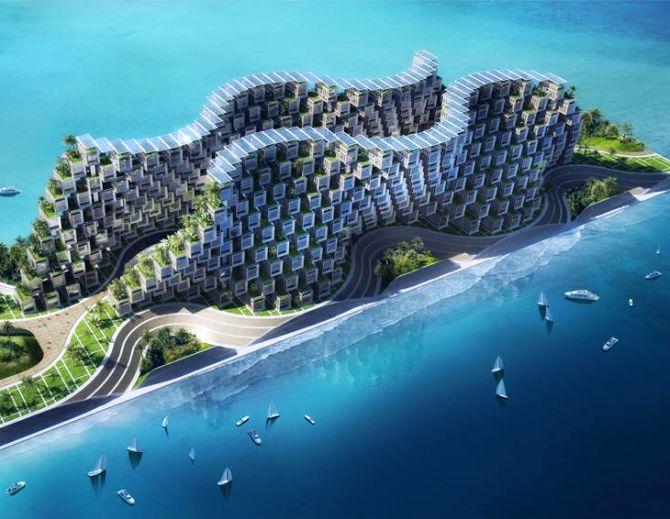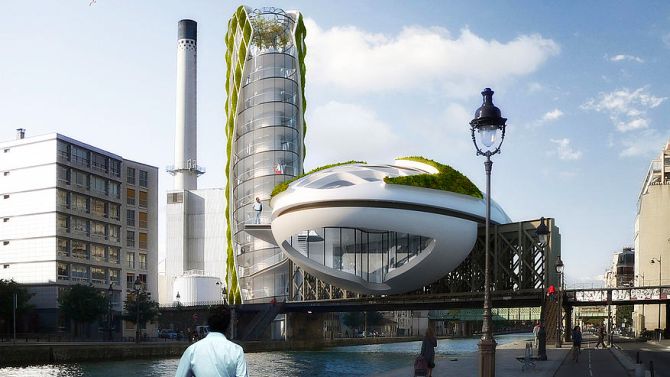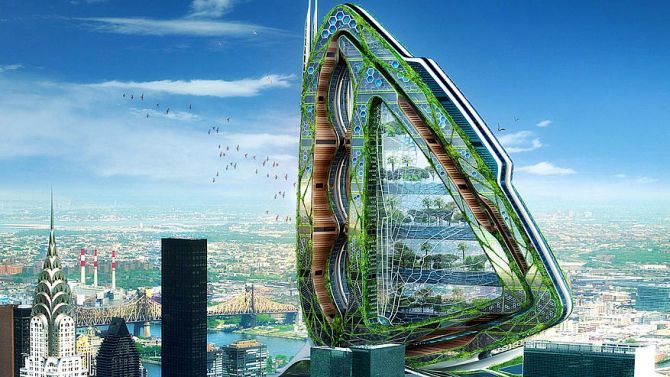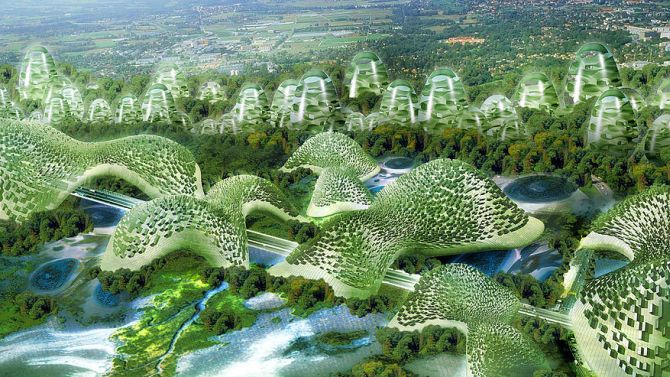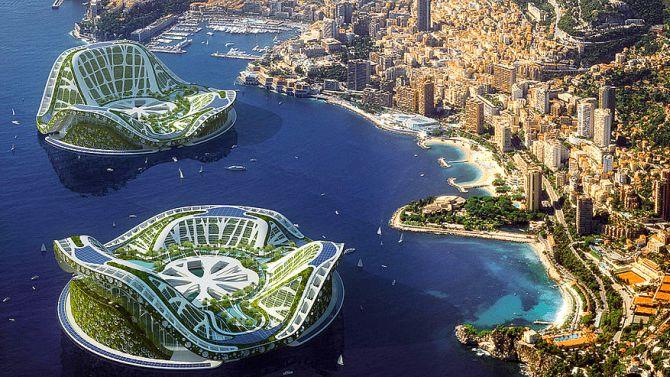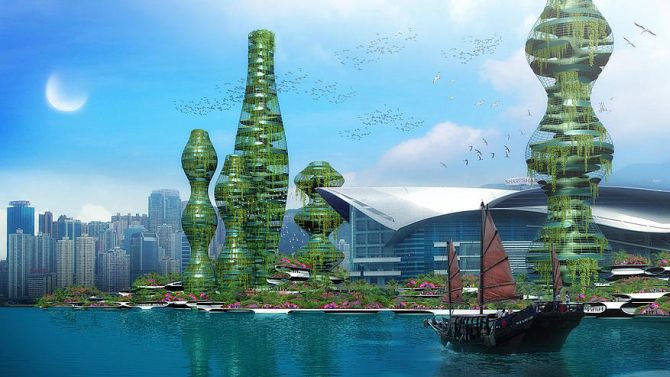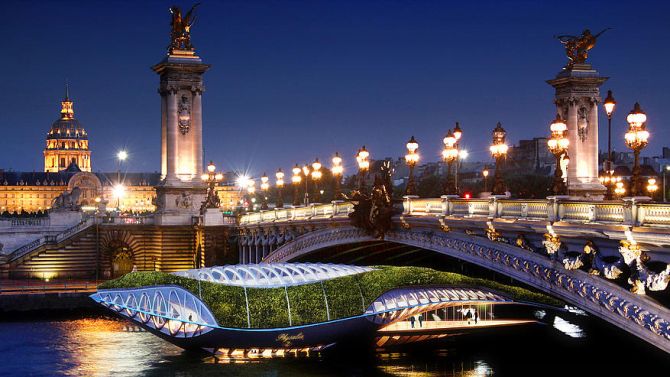 | « Back to article | Print this article |
Future cities: Concepts that can revolutionise the way we live
Belgian architect Vincent Callebaut has come up with some futuristic concepts of what the green cities of tomorrow might be like.
Coral Reef: Passive Houses for Haiti
Devastated by a massive earthquake in 2010, Haiti is in desperate need of rebuilding.
This utopian eco village could house up to 1000 refugee families. It would be built upon earthquake resistant piers off the coast out of pre-fabricated modular units.
The houses would be energy positive, carbon neutral and powered by a number of renewable energy sources like thermal energy conversion, that is energy generated from the temperature difference of warm and cold ocean currents or winds, marine energy, vertical wind turbines and solar panels.
The roof of each module would double as the garden for their respective inhabitants. The area between the two module towers would house a tropical ecosystem for the local fauna and flora.
Aquaculture farms and water recycling facilities would filter the water before sending it to the sea.
Click NEXT to read more...
Powered by ![]() To read more such stories Click Here!
To read more such stories Click Here!
Future cities: Concepts that can revolutionise the way we live
Anti-Smog: Cleaner Air for Paris
Project “Anti-Smog” was set up in 2008 to fight Parisian air pollution with all renewable energy sources possible.
The Anti Smog Eco Boulevard would be centered around the Solar Drop Tower which would be covered in 250 square meters of photovoltaic panels.
The panels are covered in a layer of titanium dioxide which reacts with ultraviolet rays and the smog particles, filtering and dissipating them.
A second component would be the Wind Tower, consisting of plants and wind turbines.
Click NEXT to read more…
Powered by ![]() To read more such stories Click Here!
To read more such stories Click Here!
Future cities: Concepts that can revolutionise the way we live
Dragonfly: Vertical Farming in New York City
The Dragonfly would be a completely self-sustaining ecosystem—living on renewable energy from solar, wind and water—that also provided food.
Housing units and work offices would be interspersed with meadows, farms, and greenhouses.
The concept is directly inspired by the exoskeleton of a dragonfly – its’ metal and glass wings house the plant and animal farms. Exterior vertical gardens filter the rain water which is reused – together with domestic liquid waste – for farming needs.
The space between the wings collects the warm air from the complex to heat the building in winter while natural ventilation would cool the air during summer.
Powered by ![]() To read more such stories Click Here!
To read more such stories Click Here!
Future cities: Concepts that can revolutionise the way we live
Landscript: Geneva Goes Green
The Landscript concept tries to remodel a 220-hectare industrial area on the outskirts of Geneva in Switzerland. Due to heavy industrial activity, the area today is almost devoid of vegetation.
The newly developed landscape would allow the integration of water into this urban space to restore vegetation.
The shape of the area mimics natural surroundings in the form of cocoons, atolls and mountains.
Landscript is based on the idea of creating a self sufficient urban environment by copying natural processes. The buildings would produce their own energy with biogas plants, photovoltaic panels and wind turbines.
Click NEXT to read more...
Powered by ![]() To read more such stories Click Here!
To read more such stories Click Here!
Future cities: Concepts that can revolutionise the way we live
Lilypad: Floating City for Climate Refugees
Climate change and its’ impacts – especially rising sea levels – will leave more and more people homeless and displaced in the future. The Lilypad Floating City is a concept for a completely self-sufficient, floating city intended to provide shelter for potential climate refugees.
The city is designed to look like a waterlilly and is supposed to be a zero-emission living area using solar, wind, tidal energy and biomass power. It would also absorb CO2 from the atmosphere into its Titanium Oxide skin.
Click NEXT to read more...
Powered by ![]() To read more such stories Click Here!
To read more such stories Click Here!
Future cities: Concepts that can revolutionise the way we live
The Perfumed Jungle: Hong Kong
Hong Kong is one of the most populated territories in the world, with a density of around 6700 inhabitants per square kilometres. This artificial harbour aims at renaturalizing the urban landscape and increasing real estate availability.
The exteriors and interiors of these newly developed and naturally shaped skyscrapers would be covered in vertical gardens and vegetation.
The areas between the buildings would be a mix of lawns, streams and lakes, together building up the city’s new green lung that would help to get rid of smog and pollution. Renewable energy sources like tidal energy or biogas plants wwould also help to further reduce the CO2 footprint.
Powered by ![]() To read more such stories Click Here!
To read more such stories Click Here!
Future cities: Concepts that can revolutionise the way we live
Physalia: Travel and Clean European Waterways
Physalia is a concept for an amphibious garden in a ship’s body that would navigate around European rivers. It would clean the waterways while allowing people to travel around.
The vessel’s roof would be covered with solar cells to power the engines, backed up by additional hydro-turbines under the hull. Again, the entire structure would be covered in titanium dioxide which helps to absorb CO2 – this time in the water.
Physalia’s hull contains a hydraulic network that cleans the passing waters. A hydraulic pump would lift the water to the ship’s roof where the vegetation would filter it.
Powered by ![]() To read more such stories Click Here!
To read more such stories Click Here!
